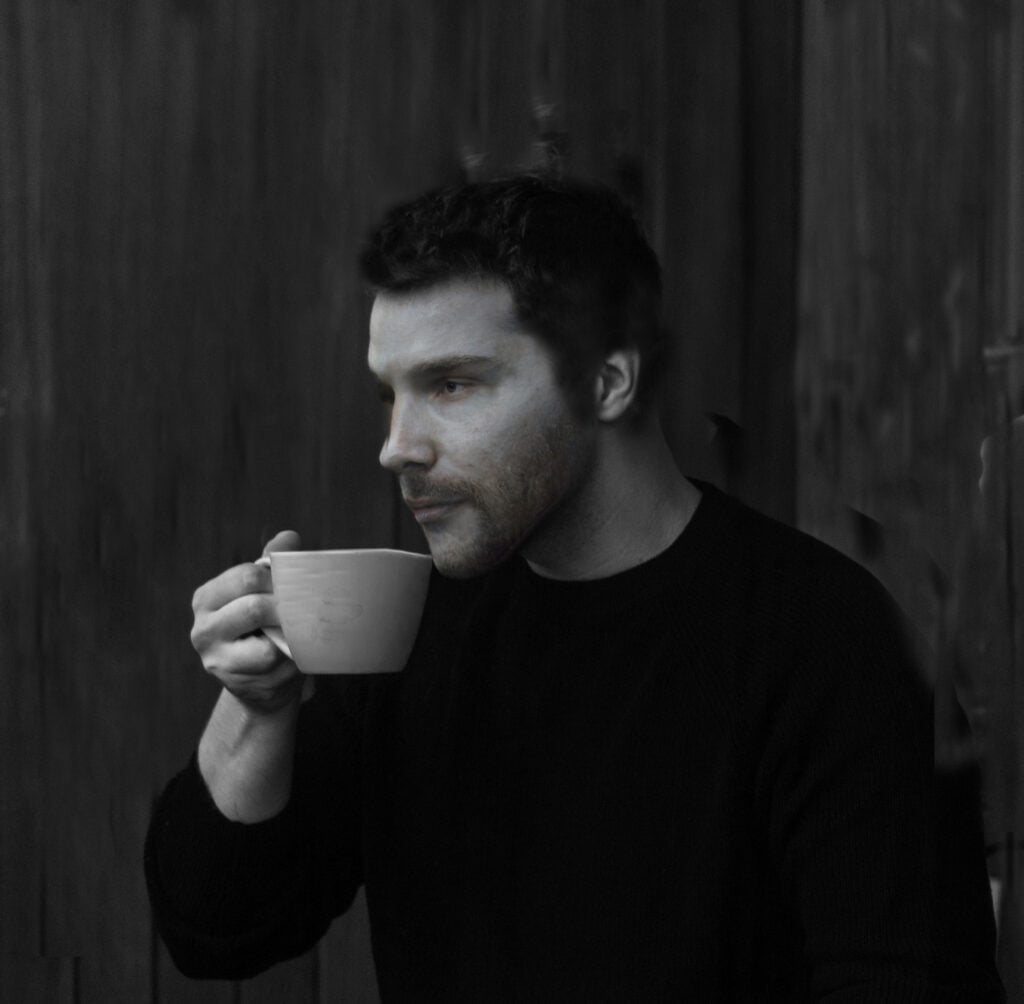Coffee aroma is the delicious smell that greets you when you open a bag of beans or walk into a café. This complex fragrance comes from over 800 different aromatic compounds that develop during roasting and brewing. Your nose picks up hints of what’s to come—chocolate, caramel, nuts, fruits, or floral notes that preview the coffee’s flavor.
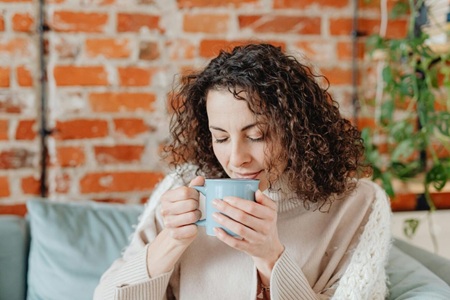
The smell of coffee affects how it tastes. From nutty and chocolatey to fruity or floral, every cup has its own unique scent. This blog will cover what coffee aroma means, how to describe it, and what affects the smell. You’ll find something interesting here, whether you’re a casual drinker or a coffee lover.
How to Describe the Smell of Coffee?
Describing coffee’s smell becomes easier when you connect it to familiar scents from everyday life, like nutty, fruity, or chocolaty notes. Your nose can pick up different aromatic notes that tell a story about the coffee’s origin and roast level.
- Nutty smell like roasted almonds, hazelnuts, or peanuts—warm and toasty scents that add richness to the overall fragrance.
- Fruity notes remind you of berries, apples, or citrus peels, bringing bright, tangy touches that make the coffee smell fresh and lively.
- Earthy scents carry the smell of fresh soil after rain or a damp forest floor, offering deep, grounding aromas you’ll often find in dark roasts.
- Floral fragrances smell sweet and delicate like jasmine, rose, or lavender—light, airy notes that typically appear in lighter roasts.
- Spicy hints feature cinnamon, clove, or even pepper, adding bold and lively touches to the aroma.
- Chocolatey smells remind you of dark chocolate or cocoa powder, creating that familiar, comforting scent everyone recognizes.
- Caramel-like aromas give off sweet, buttery scents similar to toasted sugar, often found in medium roasts with smooth, rich finishes.
These are helpful terms when describing how coffee smells. You can use one or mix a few to better explain the aroma. For example, a coffee might smell “warm and nutty with hints of dark chocolate” or “bright and fruity with floral undertones.
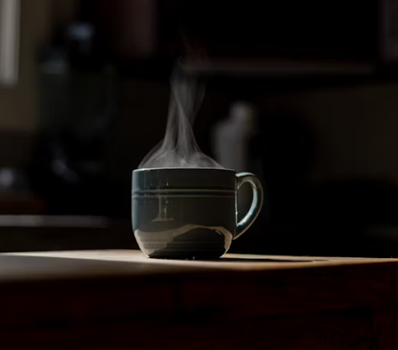
The Science Behind Coffee Aroma
Coffee aroma comes from Volatile Organic Compounds VOCs released during roasting and brewing. When coffee beans are roasted, heat triggers a chemical reaction called the Maillard reaction [1]. This reaction produces hundreds of aroma compounds.
Some of the key compounds include:
- Furans give coffee its sweet, caramel-like aroma, often reminding you of toasted sugar or syrup.
- Pyrazines are responsible for the nutty and roasted smells that make coffee feel warm and comforting.
- Phenols bring out smoky or spicy tones, adding depth and boldness to the coffee’s overall fragrance.
- Ketones and Aldehydes add floral or fruity scents, giving certain coffees a light, refreshing aroma.
Your nose can detect these compounds even in tiny amounts [2]. That’s why fresh coffee smells so rich and complex.
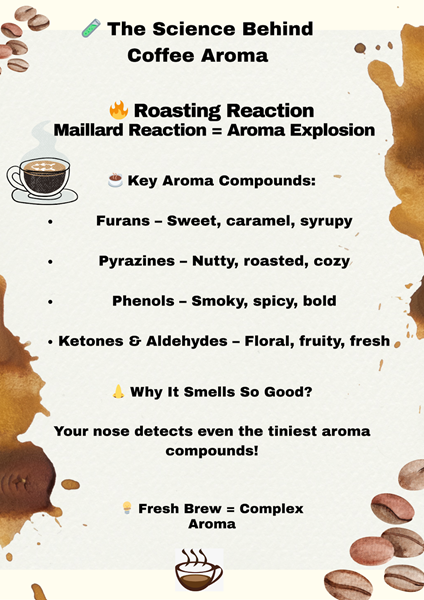
The Relation between Aroma and the Taste of Coffee
The aroma of coffee plays a big role in how it tastes. Our sense of smell and taste work closely together, so most of the flavor we notice in coffee actually comes from its smell. That’s why coffee often tastes bland or flat when you have a cold; your nose can’t detect the full aroma.
Different smells can give you clues about the flavor. For example, a fruity aroma usually means the coffee will have a bright, tangy taste. If it smells like chocolate, it often tastes smooth and sweet. An earthy smell may hint at a bold, rich flavor. The more pleasant the aroma, the more enjoyable your cup of coffee will be.
What are the Factors that Affect the Aroma of Coffee?
1. Freshness of Coffee
Freshly roasted beans deliver the strongest, most vibrant aromas because they’re packed with volatile compounds that create those enticing scents. The aroma starts fading just days after roasting and continues to weaken over weeks as these compounds escape into the air.
Ground coffee loses its fragrance much faster than whole beans because grinding exposes more surface area to oxygen. That’s why I always suggest grinding the beans yourself and right before brewing.
2. Processing and Roasting
The way coffee is processed—like whether it’s washed, natural, or honey-processed—really affects how it smells. Each method influences the final scent profile of the beans.
Roasting level plays an equally important role in determining smell characteristics [3]. Light roasts preserve delicate floral and fruity aromas from the original bean, while medium roasts develop sweet, nutty, and balanced scents through caramelization. Dark roasts create bold, smoky, and intense aromas as oils migrate to the surface and sugars break down into more complex compounds.
3. The Coffee Origin
Where coffee grows greatly influences its natural aroma because different regions produce beans with distinct scent profiles. Ethiopian coffees often carry bright fruity or floral fragrances, while Colombian beans are famous for their nutty or chocolatey aromas. Sumatran coffee typically offers earthy and spicy fragrances that reflect the island’s unique climate and soil conditions.
4. Storage and Packaging
Storing coffee properly preserves its aromatic compounds by protecting them from their main enemies: air, light, heat, and moisture. Exposure to oxygen causes volatile compounds to break down and escape, while light and heat accelerate this degradation process.
Quality packaging uses airtight seals and opaque materials to lock in those precious aromatic oils and gases [4]. Even at home, storing coffee in airtight containers away from light and heat makes a noticeable difference in how long your beans retain their inviting smell.
5. Brew method
Your brewing technique directly affects how much aroma gets released and how intensely you experience it. Pour-over and French press methods allow longer contact time between water and coffee, releasing more aromatic compounds into the air around your cup.
Espresso creates sharp, concentrated aromas because high pressure forces volatile compounds out quickly and intensely. Cold brew methods produce different aromatic profiles because lower temperatures extract different compounds, while methods like Turkish coffee create unique scent experiences through fine grinding and extended brewing times.
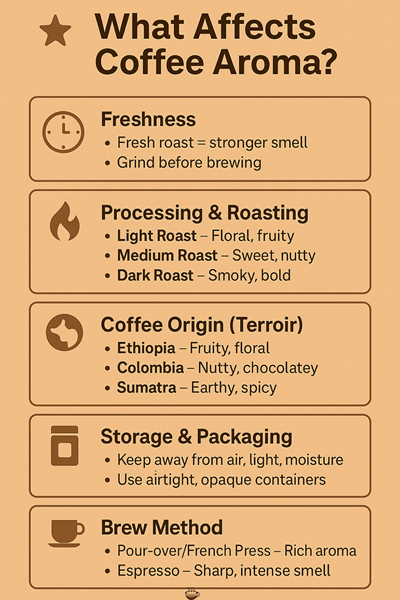
What Coffee has the Best Aroma?
High-quality Single-origin or specialty-grade coffee often smells better than blended or mass-produced options.
Arabica beans are known for a better aroma than Robusta. Some of the most aromatic coffees include:
- Ethiopian Yirgacheffe: Floral and citrus smell
- Panama Geisha: Sweet, jasmine-like aroma
- Colombian Supremo: Nutty and caramel notes
- Yemni Mocha: Rich, chocolatey aroma with hints of spice
Freshness and brew method also matter. Even the best beans won’t smell good if stored poorly.
FAQs
Does Caffeine have Aroma?
No, caffeine itself doesn’t have a smell. The aroma comes from other compounds released during the roasting process. So, decaf coffee can still smell amazing, even without caffeine.
How long does coffee aroma last?
Brewed coffee smells best right after you make it, but the aroma fades within 15–30 minutes. Whole beans keep their smell for about 2–4 weeks after roasting. Ground coffee loses its aroma faster, usually within a few hours.
How to Preserve the Aroma of Coffee?
To preserve the aroma of coffee, store the beans in an airtight, opaque container that blocks out light and air. Place the container in a cool, dark area, away from heat, moisture, and direct sunlight. Only grind the amount of coffee you need right before brewing to lock in the aroma.
Does Better Aroma mean Better-tasting Coffee?
Typically, if the coffee has a strong and nice smell, it means it’s going to taste pretty good. But not always. Personal taste matters too. Some people like bold, dark roasts. Others enjoy light and fruity ones.
What does Aroma mean on a Coffee Maker?
“Aroma” button on a coffee maker is a special setting designed to bring out the best flavor and smell from your coffee. Instead of releasing all the water at once, the machine brews in slow, 30-second intervals. It takes longer—about twice as long as a regular brew—but the result is a more full-bodied, aromatic cup that’s worth the wait.
References:

